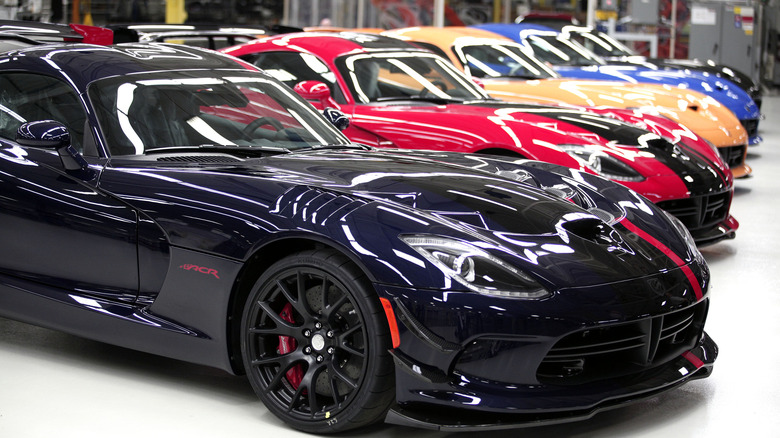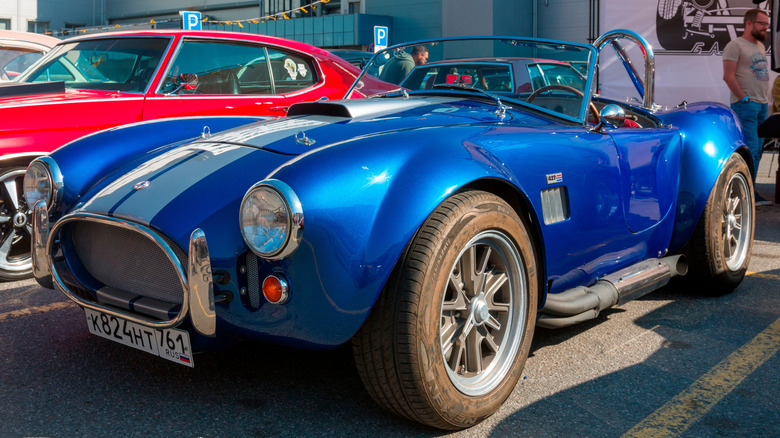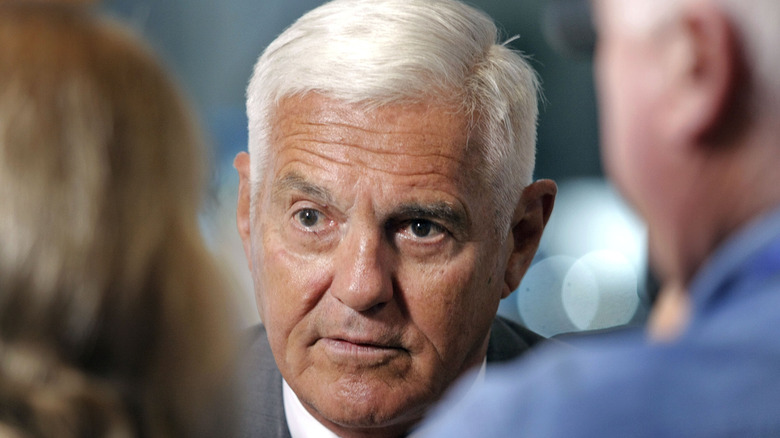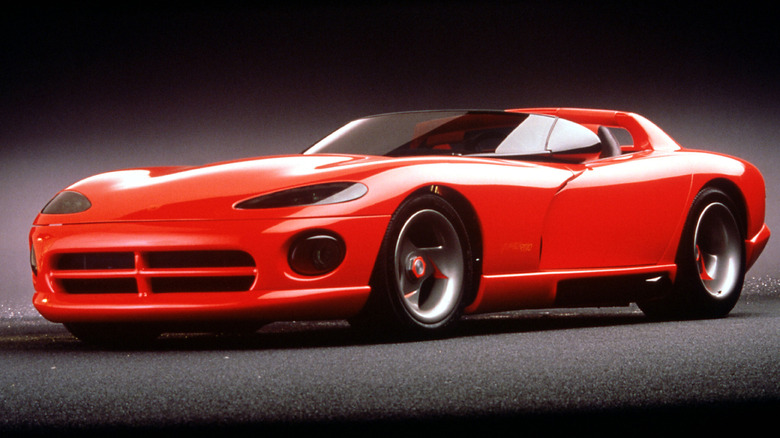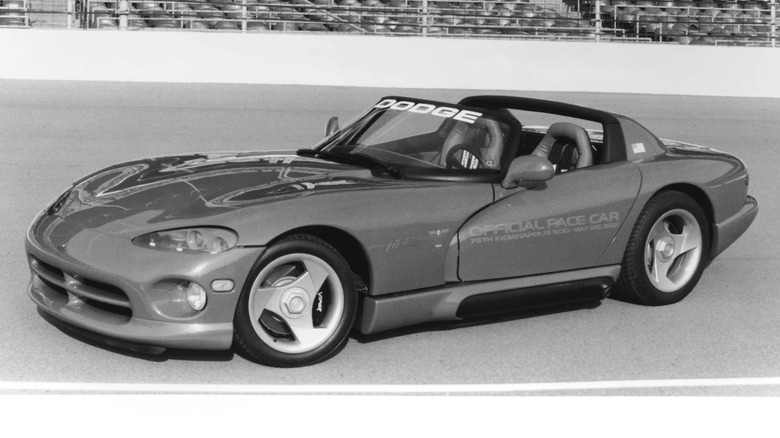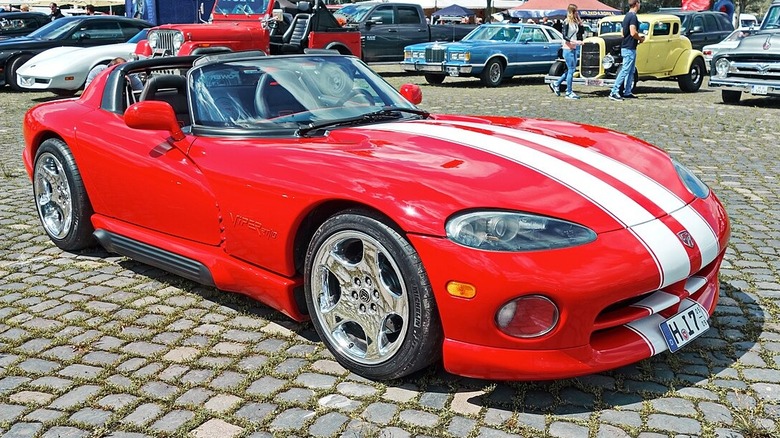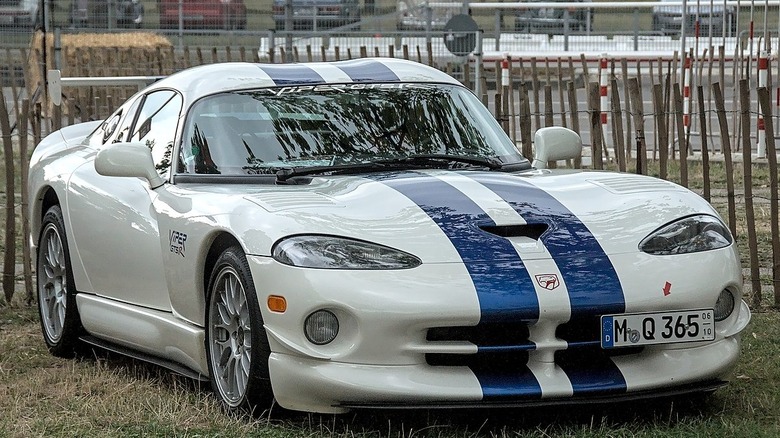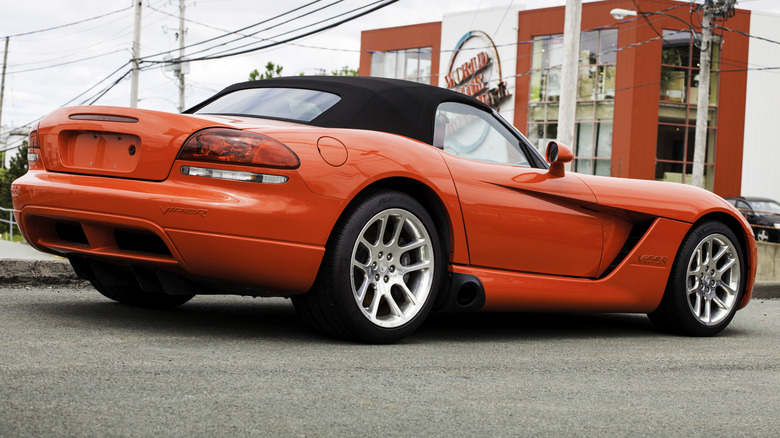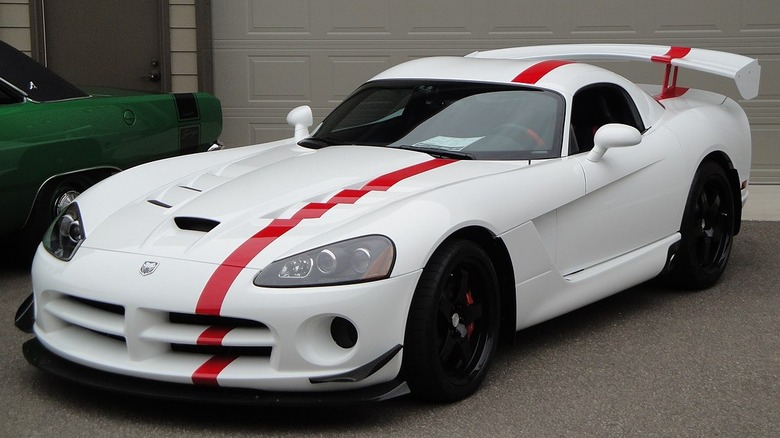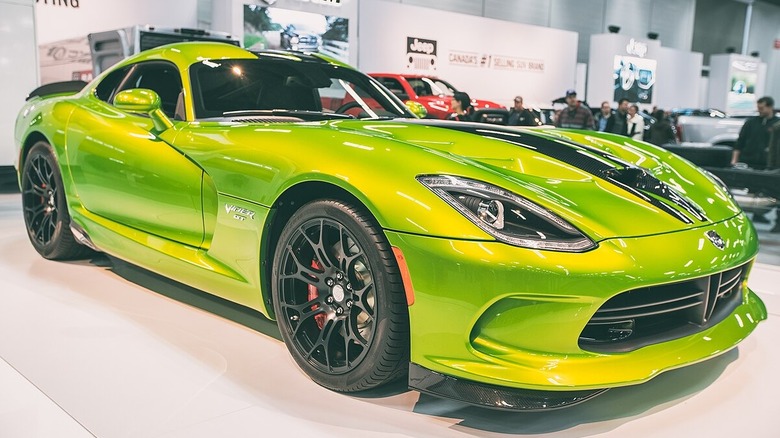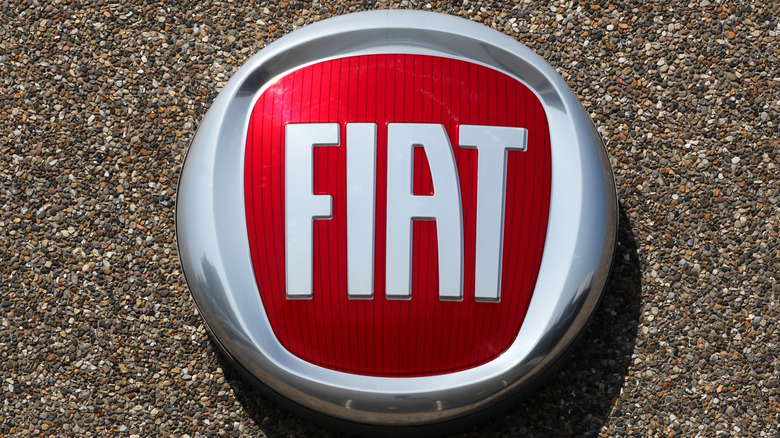Dodge Viper: The Rise And Fall Of A Fan-Favorite Supercar
Although in the grave for seven years and counting, the Dodge Viper remains one of the most famous nameplates in supercar history. Brutally powerful, charmingly uncouth, and undeniably menacing, the Viper caught and held the attention of the car-buying public for 25 years.
However, the Viper's history actually dates back to the 1960s, and not in the way one might think. Its true genesis lies across the Atlantic Ocean in the nascent post-war cottage industry of British carbuilders. The relationship between British and American car builders has long been one of competition and collaboration. The Lola Mk 6 GT sired the original Ford GT40, and several classic British cars stuffed American V8 engines under the hood. The two nations might drive on opposite sides of the road, but each can agree: British style and American power are as classic a combination as peanut butter and chocolate.
The tale of the Viper begins in an unlikely place: a lesser-known British Roadster called the AC Ace, which car honks might recognize as the progenitor of another American legend, the Shelby AC Cobra. Join us as we document the rise and fall of one of America's fan-favorite supercars: the Dodge Viper.
From England to America: a performance evolution
The story of Carroll Shelby has been exhaustively documented in gearhead magazines, documentaries, and even major motion pictures, like 2019's "Ford v Ferrari," which portrayed one of motorsports' greatest triumphs.
In 1962, respected race driver Carroll Shelby oversaw an engine transplant in a garage in Southern California. Shelby had won the 1960 24 Hours of LeMans two years prior, driving an Aston Martin, but a heart issue forced him out of the cockpit. From then on, he embraced a new challenge: building cars rather than racing them.
His vision was to take a car he knew from his racing days, a British AC Ace, and Americanize it. The Ace ran on a 2.0-liter straight-six engine and had already earned itself a reputation as a competent racer. Shelby instead opted for a 4.2-liter Ford V8 to nestle into the engine bay of the diminutive roadster. The rest is history, quite literally.
Despite its small production run, the Shelby Cobra left an indelible mark on automotive lore. Its rarity only increased its significance — so much so that more than 60 years later, the Cobra remains one of the most popular kit cars of all time. And everyone knows Shelby went on to have a long and productive relationship with Ford, later using his magic to pull a similar stunt with the Lola Mk 6 GT he turned into the GT40. But what does all this have to do with the Dodge Viper?
The answer is inspiration.
Daddy Snake: Bob Lutz and the Viper
As the scion of a Swiss banking family turned Marine fighter pilot, Chrysler head Bob Lutz was used to making important decisions. Lutz had an impressive resume, which, aside from piloting the unique Grumman F9F Panther, included stints as Vice President of Sales at BMW and Vice President of Truck Operations, International Operations, and Chairman of Europe at Ford.
By the time Lutz took over Chrysler Motors, including the Dodge brand, in 1988, the carmaker was heading into uncertainty. Through the 1980s, Dodge had made its hay with successful but boring additions to the automotive lexicon. The Aries K-Car and Caravan kept Dodge humming through the 80s, but the industry was on the cusp of change, and Chrysler might not survive.
Then, while driving his Autokraft Mk IV Shelby Cobra around the rural roads of Michigan, Lutz struck upon an idea: Chrysler would take its cues from the Cobra rumbling beneath Lutz's rear end and build a rough-and-tumble performance car. Surely there was a place in the world for an overpowered monster that could take on Chrysler's competition — the Corvettes, Mustangs, and Camaros of the world — perhaps even the supercars coming out of Maranello.
A concept that blew the world away
Tom Gale had been with Chrylser since 1967, helping to shepherd the faltering company through two decades before being appointed head of design in 1985. He got the opportunity of a lifetime in February 1988 when Bob Lutz approached him about building a Chrysler version of the Cobra.
The mandate was clear; Chevrolet engineers were in the midst of developing a 400 hp 5.7-liter LT5 V8 for the upcoming Corvette ZR-1. Supercar performance in an affordable package had been Corvette's bailiwick for decades. Now Chrysler wanted in on the game. Gale got to work.
The first Viper concept debuted at the 1989 Detroit Auto Show. It was half-baked, with a Chrysler 360 V8 as a placeholder in the engine bay. Regardless, the two-seat, front-engined concept was smooth and futuristic, the foreword to a new chapter in Chrysler's history.
The reaction was instant and powerful. Unsolicited down payments for the new car began arriving at Chrysler, which promptly sent them back. It was only a concept, after all, but the response was such that the Viper was ordered into production, a process that would ultimately take three years.
The aging front-wheel drive platforms of the K-car and Caravan were not at all suited to what the Viper promised, but Chrysler had an ace up its sleeve. Tom Gale and the 85 engineers assigned to the Viper team were about to grab the bull by the horns.
Not quite a supercar with a truck engine
Early detractors of the Viper maligned the supercar for having a truck engine under the hood. While it was true that Chrysler was developing a V10 for its Ram truck, it also had a bull in the paddock. Chyrlser had acquired Lamborghini from the entrepreneurial Mimran brothers in April 1987 for 25.2 million dollars, and it was to Italy that it turned for help developing a V10 worthy of a supercar.
The Viper was to share an iron-blocked V10 with the Dodge Ram, a decision that was not just a cost-saving measure but also a strategic move to leverage Chrysler's existing resources. However, the Chrysler Lamborghini team didn't just settle for the standard engine. They took the engine and recast it with an aluminum alloy block and head, adding a bit of Italian flair to the American muscle.
The final product would be an 8.0-liter V10 with a 4-inch bore and a 3.9-inch stroke. Mated to a Tremex six-speed, it sent 400 hp at 4,600 rpm and 465 lb-ft of torque to the rear wheels — Corvette-punishing numbers.
The Viper first hit the track in 1991, but not in the way you might expect. The 1991 Indianapolis 500 was slated to have a pair of Japanese-built Dodge Stealths serving as pace cars. When the United Auto Workers union took umbrage, Chrysler shifted. The new Dodge Viper roared onto the track and never looked back.
A snake let loose: 1992-1996 Viper SR I
Chrysler finally released the first-generation Dodge Viper R/T 10 in the spring of 1992. Essentially a V10 drivetrain with wheels, the list of the things the first-gen Viper lacked would make any grand touring fan swoon from the exhaust fumes.
Windows were made from vinyl that zipped open and closed, and there was no air conditioning or airbags. The thing even lacked a roof until Chrysler begrudgingly made removable hard tops available. Chrysler was sending a message with its bare bones super car: Anything that didn't serve performance was superfluous.
With a curb weight of 3,400 pounds, the V10 pushed it to a top speed of 165 mph, slithering across the first 60 in 4.4 seconds. It was no daily driver, it was a race car you could slap a license plate on if you could cough up the $50,000 MSRP. Considering the $67,000 MSRP for the 1990 ZR-1, it was clear the Viper team had set a new bar.
The SR1, as the first-gen Viper came to be known, sold about 6,000 units between 1992 and 1995. Considering that Chevrolet produced around the same 6,000 units of its ZR1 between 1990 and 1995, the Viper's rookie numbers looked good. It had its drawbacks, but none were enough to stop the second generation from getting the green light.
[Featured image by More Cars via Wikimedia Commons | Cropped and scaled | CC BY-SA 2.0]
Onward and upward: 1996-2002 Viper SR II
With plenty of buzz and a firm foothold in the performance market, Chrysler was ready to put its best foot forward for the second-generation Viper. As it came to be known, the SR II needed to address some of the lack of refinement in the inaugural edition. It may be on par, if not slightly superior, to the Corvette on a track, but the 'Vette was more refined.
The team, still led by Tom Gale, cleaned up the Viper by adding some of the things it so publicly lacked. Released in 1996, the new Viper offered two body styles: the first gen-derived RT/10 and a GTS Coupe that came halfway through the model year.
More than 90% of the GTS was new, as Dodge had combed through the car, inspecting each piece for potential replacement in the name of weight savings. The result was a GTS that weighed 200 pounds less than the first-gen, despite the addition of air conditioning.
The second generation also saw the introduction of two special editions: the GT2 Commemorative Edition, which marked the Viper's driver and constructor wins in the FIA GT2 racing series, and a Viper American Club Racer (ACR) edition, which pulled the Viper back toward the race end of the spectrum.
Dodge built 10,000 SR II Vipers, with the GTS outselling the RT/10 by a ratio of 2:1. Unbeknownst to anyone at the time, it would be the best-selling run of any Viper generation.
[Featured image by Alexander Migl via Wikimedia Commons | Cropped and scaled | CC BY-SA 4.0]
More than a fresh face: 2003-2006 Viper ZB I
The ZB I Viper arrived in the model year 2003. While considered separate generations, the SR I and II Vipers were more of a mid-gen facelift as both cars shared the same chassis. For the ZB I, Dodge's burgeoning Street and Racing Technology (SRT) division had its fingers deep in the Viper pie, and it showed.
The third-generation ZB I Viper had an all-new chassis and an aesthetic redesign courtesy of SRT design maven Osamu Shikado. Curves turned into creases. Functional hood louvers improved engine airflow. The rear fascia received a facelift, upgrading aerodynamic performance. Form followed function, and the result was the most streetable Viper yet, though few would call it tame.
The new chassis stiffened everything up (and made the ZB I more of a true generational renewal than the SR II). The V10 got a displacement bump up to 8.3 liters. Horsepower was up to 506 at 5,600 rpm. Torque numbers also improved, making an estimated 525 lb-ft at 4,200 rpm.
More than a decade from its inception, the Viper was well ensconced in the supercar world. It more than held its own against the likes of Corvette, Porsche, and Ferrari on race tracks worldwide. However, the Viper had reached its high water mark. Dodge skipped building a new 2007 model entirely (to focus on the next-gen). About 8,000 ZB Is were produced, 2,000 fewer than SR IIs, but still far more than following generations.
A supercar on the wane: 2008-2010 Viper ZB II
Despite skipping the 2007 model year, the next Viper to hit the streets fell into a similar category as the SR II. That is, it was more of a generational refresh than an all-new Viper, though the improvements were significant.
Dodge tweaked displacement again, adding a tenth of a liter. The new 8.4-liter V10 nonetheless powered up to 600 hp and 560 lb-ft of torque. Progress is grand. That power came wrapped in a coupe or a convertible, dubbed the SRT-10, and priced around $83,000.
Dodge claimed a top speed of 197 mph for the convertible and 202 mph for the coupe. Car and Driver verified the Viper's prowess, recording 0-60 mph times of 3.7 seconds and 0-100 mph times of 7.6 seconds. A sub-3-minute swoop around Virginia International Raceway outperformed the Corvette Z06, Ford GT, Porsche 911, and Audi R8.
With a two-year production run, Dodge built only 2,800 ZB II units — an indicator that despite setting a Nürburgring lap record in 2010, the Viper might be shedding its final skin; only 2,766 came off the line, the fewest yet.
[Featured image by Greg Gjerdinkgen via Wikimedia Commons | Cropped and scaled | CC BY 2.0]
A serpent's swan song: 2013-2017 Viper XVI
The fifth-generation Viper XVI seemed intent on going out in a blaze of glory. The beloved nameplate appeared after a brief hiatus with a glorious new redesign. Every generation of Dodge Viper had been faster than the previous, and the final Viper arrived to put an exclamation point at the end of a sentence Bob Lutz and Tom Gale began writing back in 1989.
More powerful than ever, the "truck engine" — still with an 8.4-liter displacement — produced 640 hp and 600 lb-ft of torque. Body panels got the carbon fiber and aluminum treatment. Brembo brakes with aluminum calipers and vented rotors improved stopping power.
Design-wise, the hand-built XVI takes the best of all possible Vipers. Flowing and curved while retaining some of its angular menace, anyone who wanted one of the previous Vipers would surely drool over this one. In 2015, power topped out at 645 hp, pushing the ultimate Viper to a 0-60 time of 3.5 seconds.
The lifespan of the Viper was dwindling, but the uniquely American supercar would go out on top. A 2016 Viper ACR set no fewer than 13 individual SCCA production-car track records.
[Featured image by IQRemix via Wikimedia Commons | Cropped and scaled | CC BY 2.0]
Wait... who owns Chrysler again?
The final Dodge Viper rolled off the assembly line in August 2017, ending an era of a beastly and uniquely American vision for a fire-breathing supercar that kowtowed to none — except the market.
Though introduced to great fanfare in 2013, the XVI Viper had not met sales expectations. The hated Corvette offered all trims at lower prices, and its performance was pretty darn close to that of the Viper. The Viper was badder and beastlier than ever, but economics is the bottom line. If you can't sell, you can't build. While the Viper may have fueled Dodge's rebirth, times had changed.
Parent company Chrysler had gone for quite a ride. In May 1998, it merged with Daimler. After claiming a $1.5 billion loss in 2006, Daimler jettisoned the beleaguered company, and while it ended up among the auto manufacturers to receive a governmental bailout in 2008, it wasn't enough. Chrysler filed for Chapter 11 bankruptcy in 2009 in order to finalize a deal selling a significant stake to Fiat.
The Viper just didn't make sense anymore, though senselessness was part of its charm. After much discussion, FiatChrysler gave it the axe in 2017, thus ending the run of one of America's most legendary upstart performance cars.
